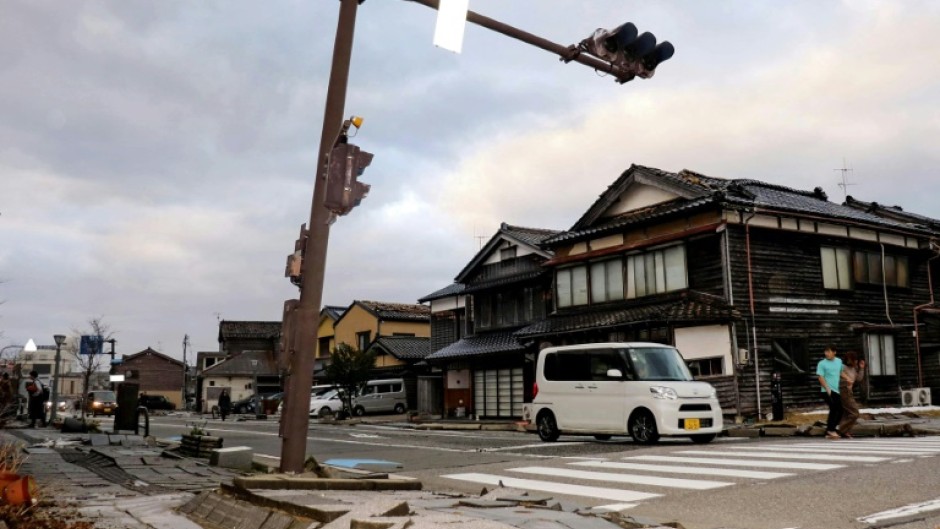
NOTO - Tsunami waves over a metre high hit Japan on Monday after a huge earthquake that damaged homes, set off a major fire, closed highways and prompted authorities to urge people to run to higher ground.
The 7.5-magnitude quake struck the Noto region in Ishikawa prefecture on the Sea of Japan side of the main central island of Honshu at around 4:10 pm (0710 GMT), the US Geological Survey (USGS) said.
Japan's weather agency put the magnitude at 7.6 and said that it was one of more than 50 quakes of 3.2 magnitude or more to rock the region on the New Year's Day holiday -- when families get together and visit shrines -- over several hours.
Television channels interrupted normal services with special programming including of Prime Minister Fumio Kishida urging people in danger areas to "evacuate as soon as possible" to higher ground.
"We realise your home, your belongings are all precious to you, but your lives are important above everything else! Run to the highest ground possible," an alarmed presenter on broadcaster NHK told viewers.

Waves at least 1.2 meters (four feet) high hit the Wajima port only around 10 minutes after the strongest quake, and a series of smaller tsunamis were reported elsewhere, as far away as the northernmost main island of Hokkaido.
The Japan Meteorological Agency issued a "large tsunami" warning, meaning waves of up to five metres, but no further major incidents were reported and the JMA later downgraded its warning to tsunamis of up to three metres.
The US Pacific Tsunami Warning Center, which had warned of possible tsunamis along 300 kilometres of coast, also said around four hours after the major quake that the tsunami danger had "largely passed".
- Fire -

"I have never experienced anything like this before, it was scary. I went out right away but the ground was shaking," an elderly man told broadcaster NHK.
"I was scared to see utility poles shaking," a young boy added.
The Japanese government said it was still assessing the extent of damage caused and whether there had been any casualties from the quake, which was felt in the capital Tokyo 300 kilometres (190 miles) away.
Government spokesman Yoshimasa Hayashi said that there were reports that six people were in the rubble of collapsed buildings, but gave no further details.
Images broadcast on television showed a major fire blazing in Wajima that had engulfed a row of houses, with people being evacuated in the dark, some with blankets and others carrying babies.
"There is a large fire. We cannot immediately tell how many houses are affected by it," a firefighter with the Wajima Fire Department told AFP.
"For now, four fire engines are there" while other equipment struggled to reach the scene due to damaged roads and other obstacles, he said.
The department was swamped with calls, with "numerous" reports of people injured and trapped inside collapsed buildings, he added.
Around 33,500 households around the epicentre, in Toyama, Ishikawa and Niigata prefectures, were without power, local utilities said.

A video clip posted on social media platform X showed lines of wooden houses toppled by the quakes, with walls and roofs caved in.
"This is the Matsunami district of Noto. We are in a horrible situation. Please come and help us. My town is in a horrible situation," said a person heard in the video.
Sakhalin island and Vladivostok in Russia's far east were on "alert" due to a possible tsunami risk after the quakes in Japan, officials said.
- Bullet trains suspended -

Several major highways were closed around the epicentre, Japan's road operator said, and Shinkansen bullet train services were also suspended between Tokyo and the epicentre in Noto.
Japan experiences hundreds of earthquakes every year and the vast majority cause no damage.
The country has strict construction regulations intended to ensure buildings can withstand strong earthquakes and routinely holds emergency drills to prepare for a major jolt.
But the country is haunted by the memory of a massive 9.0-magnitude undersea quake off northeastern Japan in March 2011, which triggered a tsunami that left around 18,500 people dead or missing.
The 2011 tsunami also sent three reactors into meltdown at the Fukushima nuclear plant, causing Japan's worst post-war disaster and the most serious nuclear accident since Chernobyl.
Japan's nuclear authority said on Monday there were no abnormalities reported at the Shika nuclear power plant in Ishikawa or at other plants after the latest quake.
By Hiroshi Hiyama

